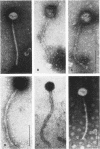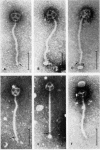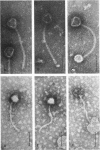Abstract
The characteristics of nine inducible temperate corynebacteriophages designated αtox+, βtox+, Ptox+, γtox−, πtox+, Ktox−, ρtox−, Ltox+, and δtox+ have been compared. Virion morphology and ability to recombine genetically with the well-studied phage βtox+ have been correlated with other properties of the phages, and the distribution of the genetic marker tox+ among related and relatively unrelated corynebacteriophages has been analyzed. The immunity specificity, host range, and plaque morphology of each phage were determined. The phages can be separated into five groups with different immunity specificities. Each type of host range previously recognized in mutants of phage βtox+ was present in one or more of the phages included in the present study, and the phages were found to produce plaques of several different morphological types. Representative phages with each of the five types of immunity specificity were further characterized with respect to virion morphology, ability to recombine with phage βtox+, latent period, average burst size, and neutralization by homologous and heterologous antiphage sera. All of these phages have polyhedral heads and long slender tails, but two distinct morphological types were distinguished by the sizes and proportions of the components of the virions. Only phages of the same morphological type as βtox+ were capable of genetic recombination with βtox+, but morphological similarity between phages was not sufficient to insure interfertility. The phages which recombined with βtox+ resembled one another in plaque morphology, latent period, and average burst size, whereas phages which failed to recombine with βtox+ differed in these characteristics. The phages capable of genetic recombination with βtox+ were found to differ from each other in immunity specificity, host range, neutralization by antiphage sera, and toxinogenicity. Thus, these latter characteristics are of limited value in establishing the extent of relatedness between corynebacteriophages. The genetic marker tox+ was not consistently correlated with any other property of the corynebacteriophages analyzed in this study. The most striking finding regarding the distribution of the tox+ marker is its presence both in βtox+ and δtox+, phages which fail to recombine genetically and which differ in virion morphology. The presence of the tox+ marker in genetically unrelated corynebacteriophages poses many questions concerning the origin(s) of tox+ and the evolution of the phage-host interactions which determine the ability of corynebacteria to synthesize diphtherial toxin.
Full text
PDF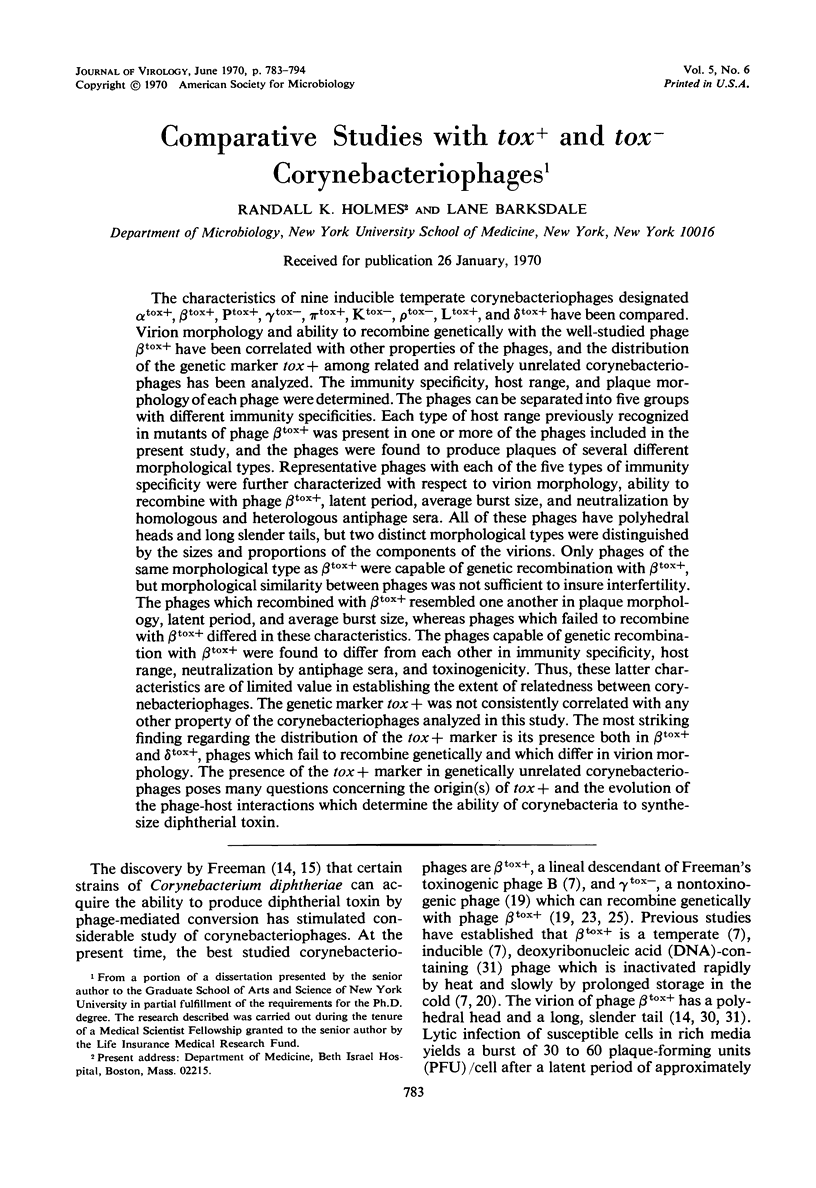
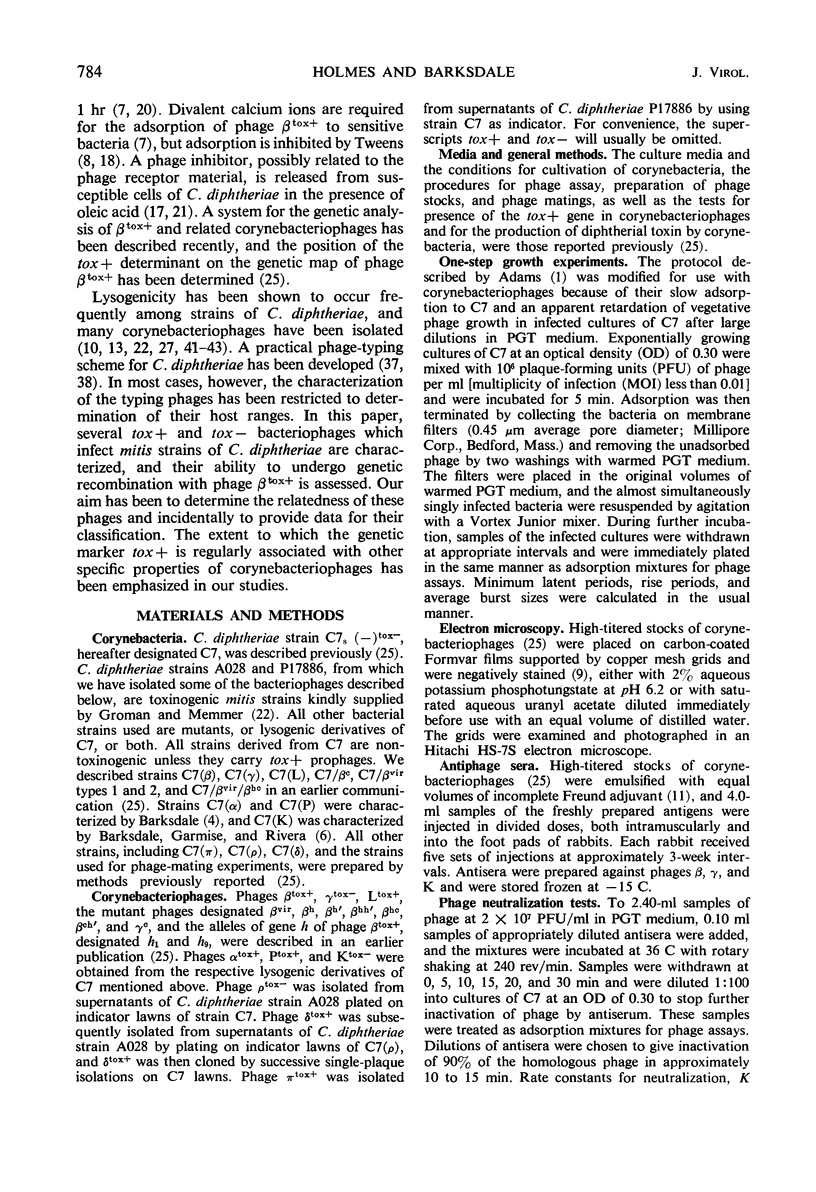
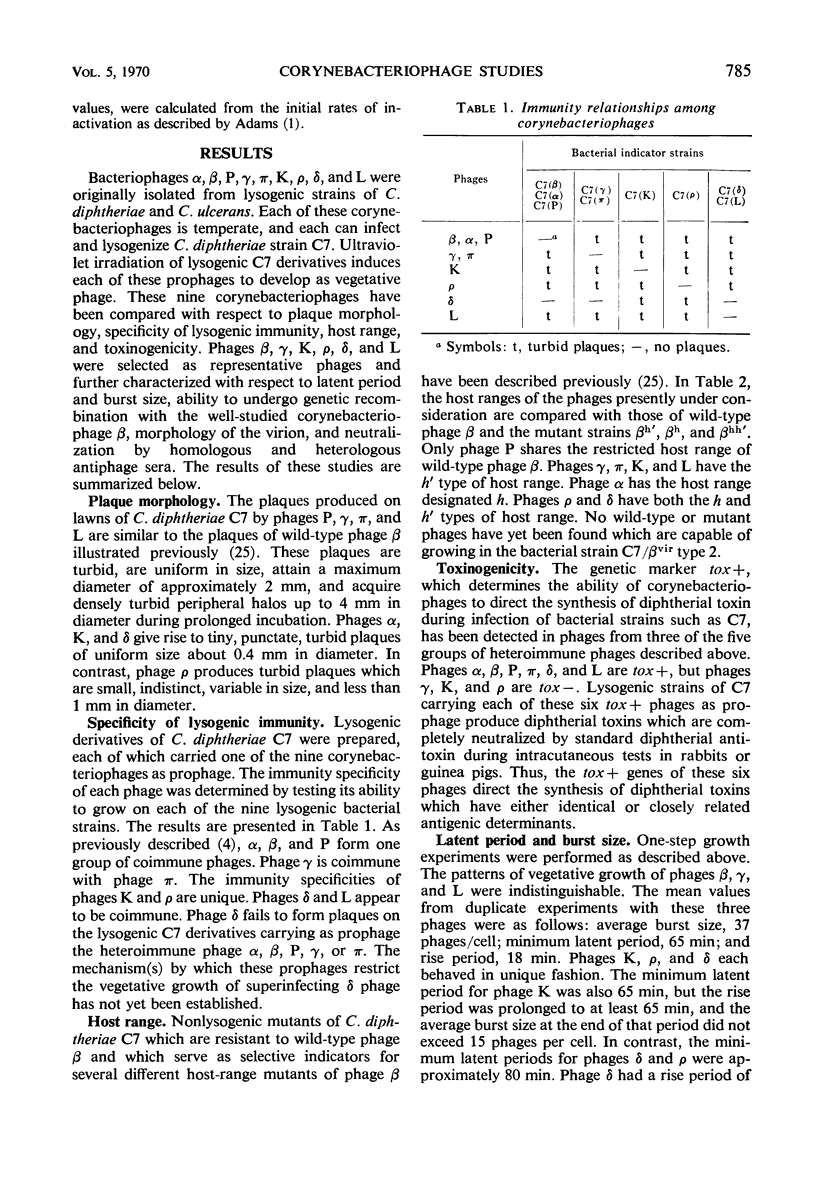
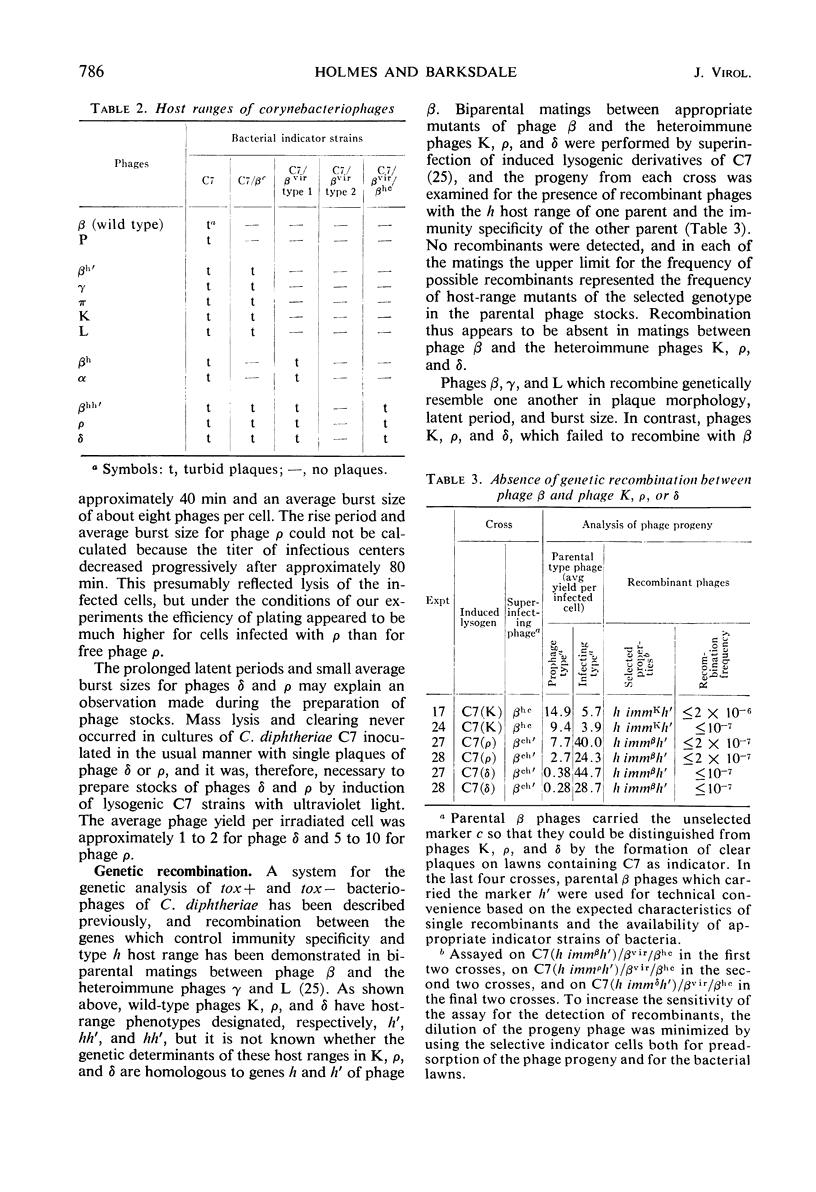
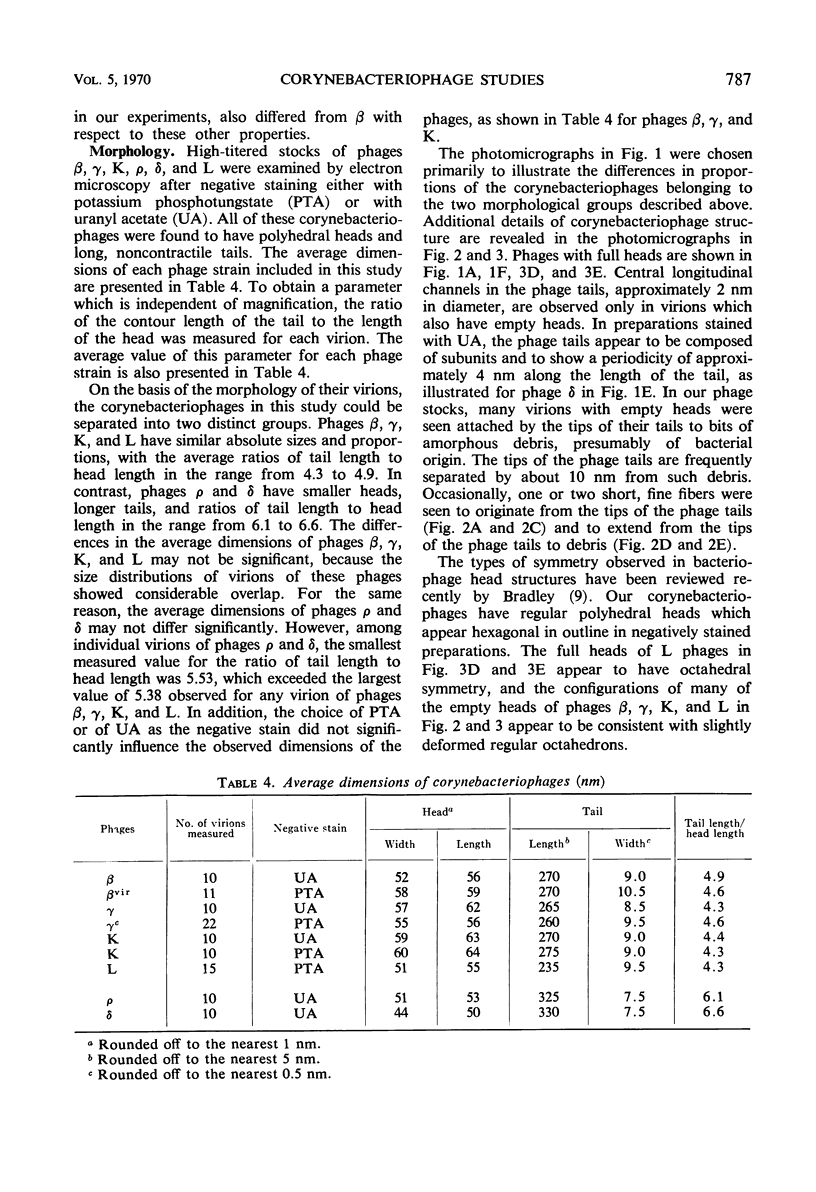
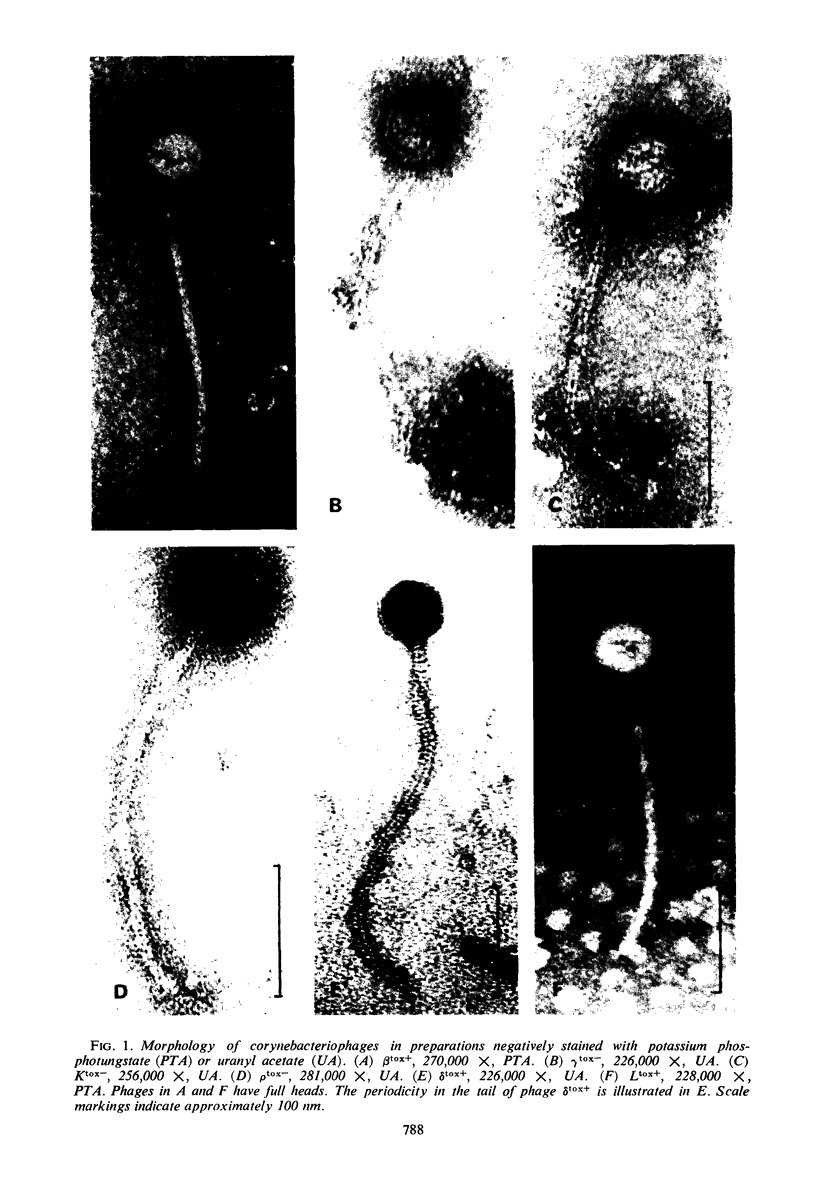
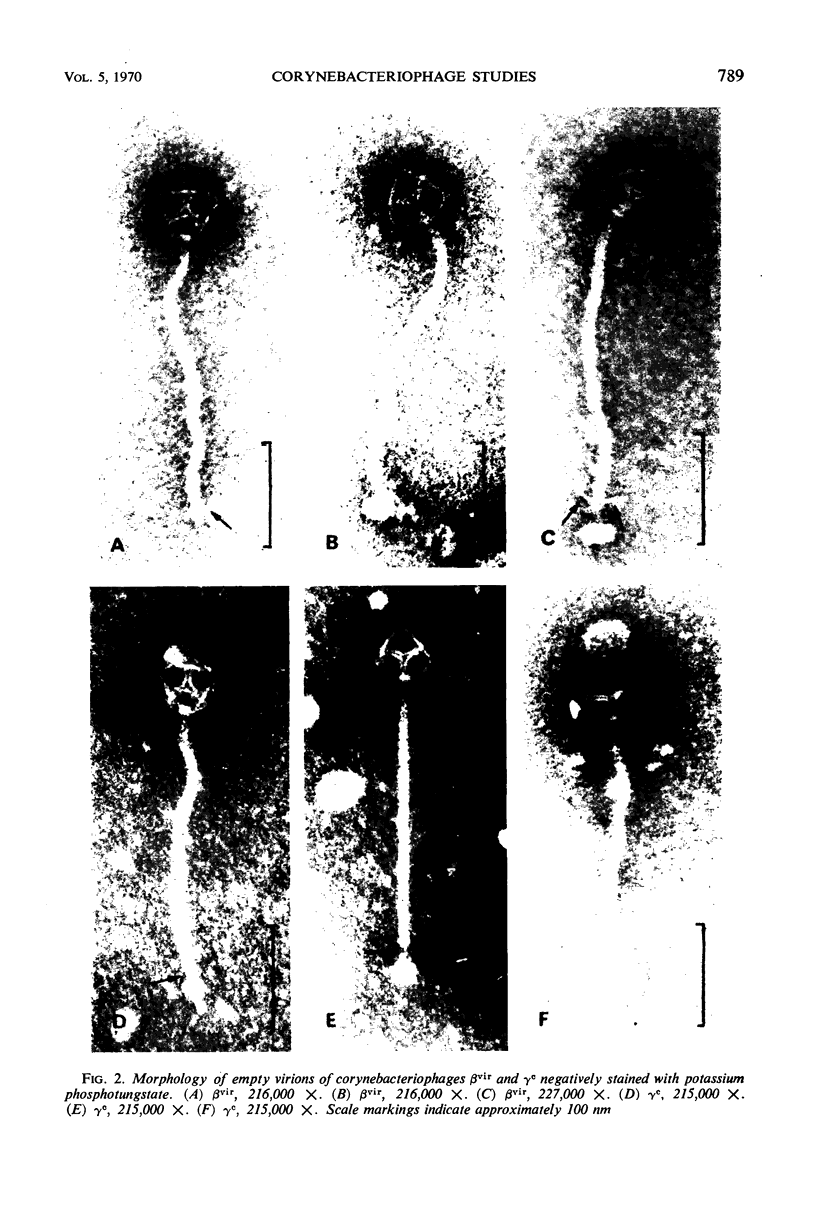
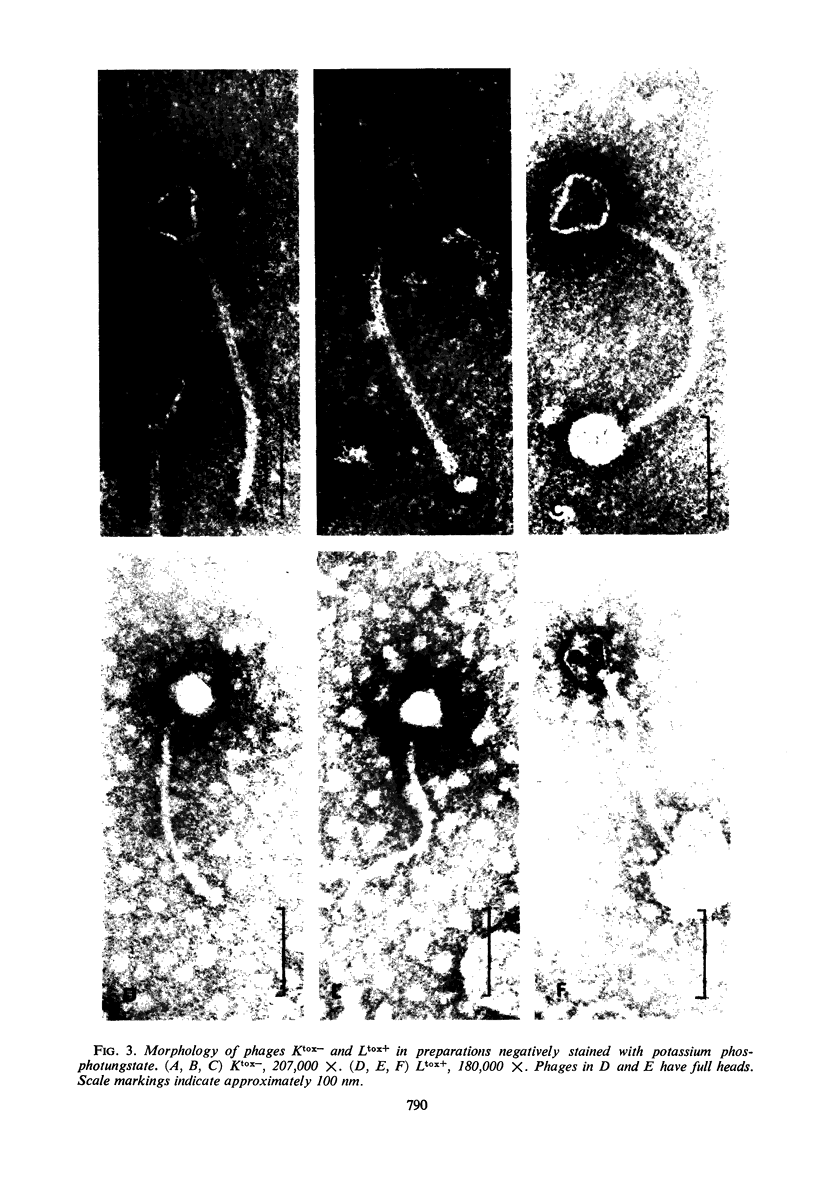
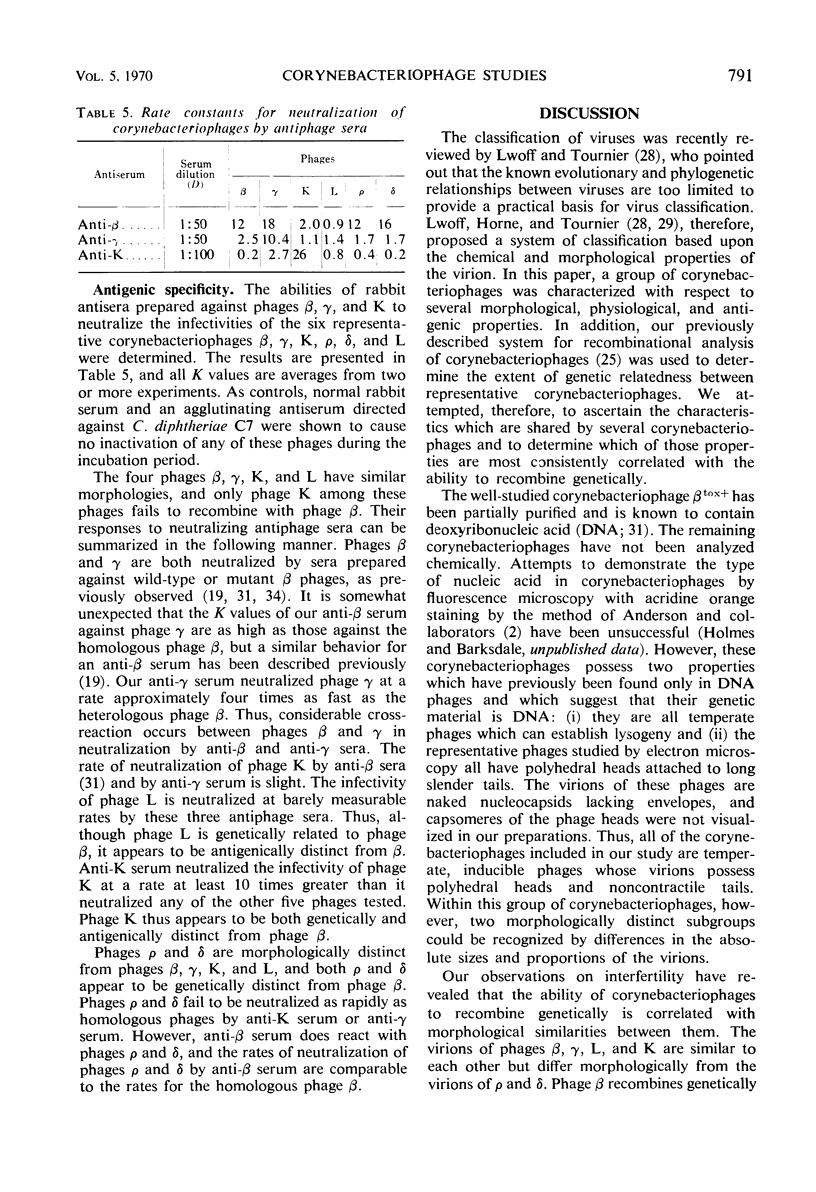
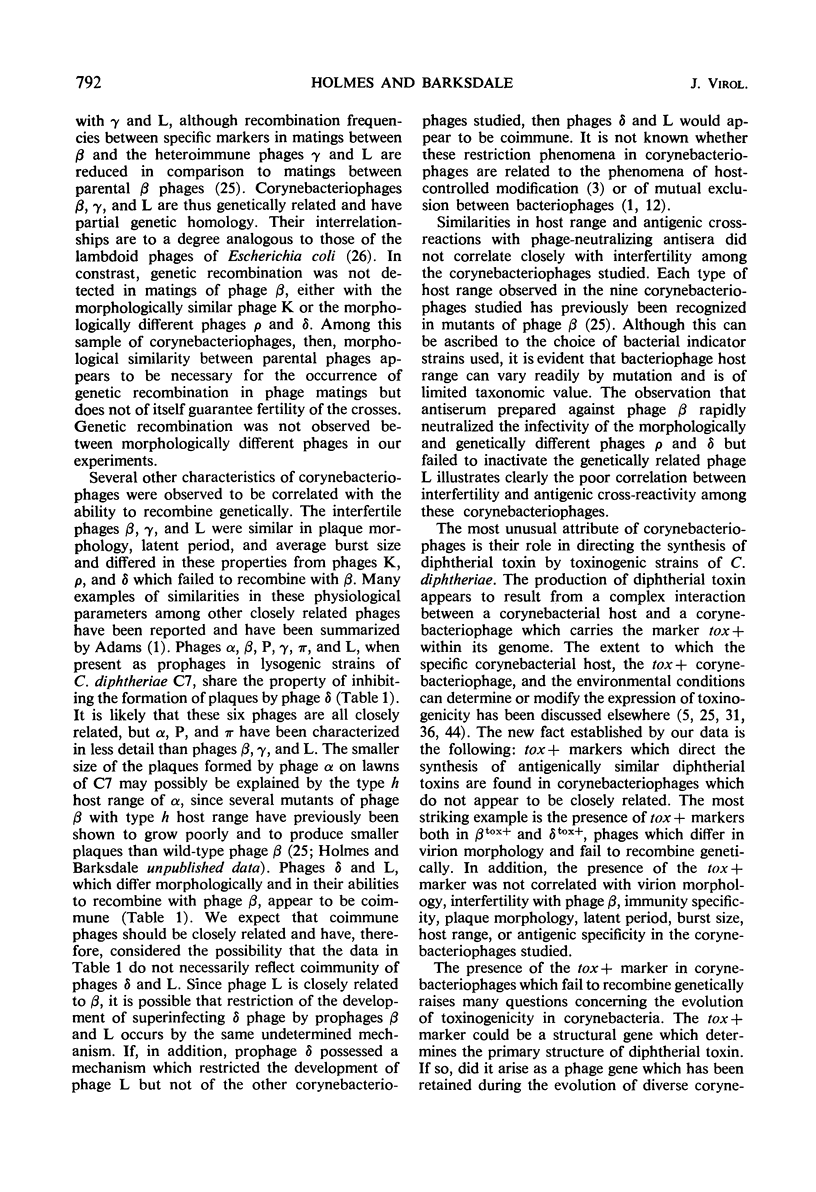
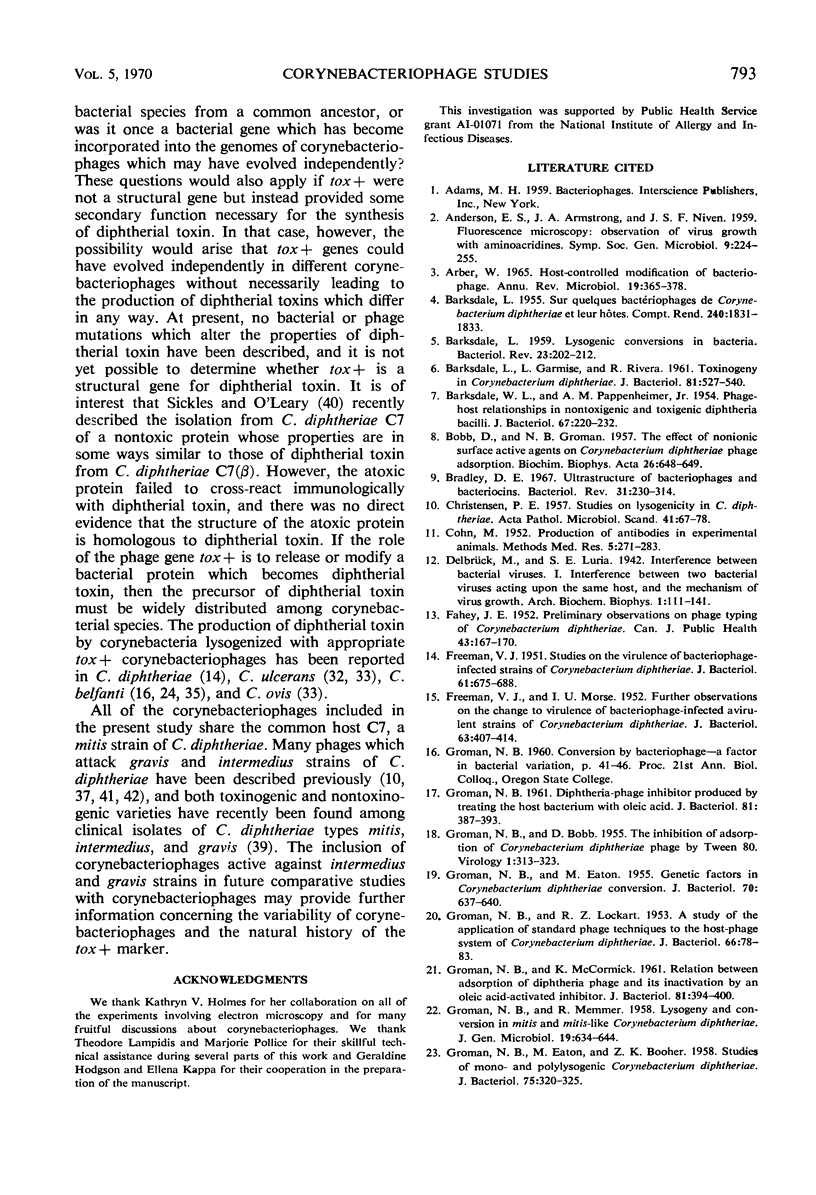
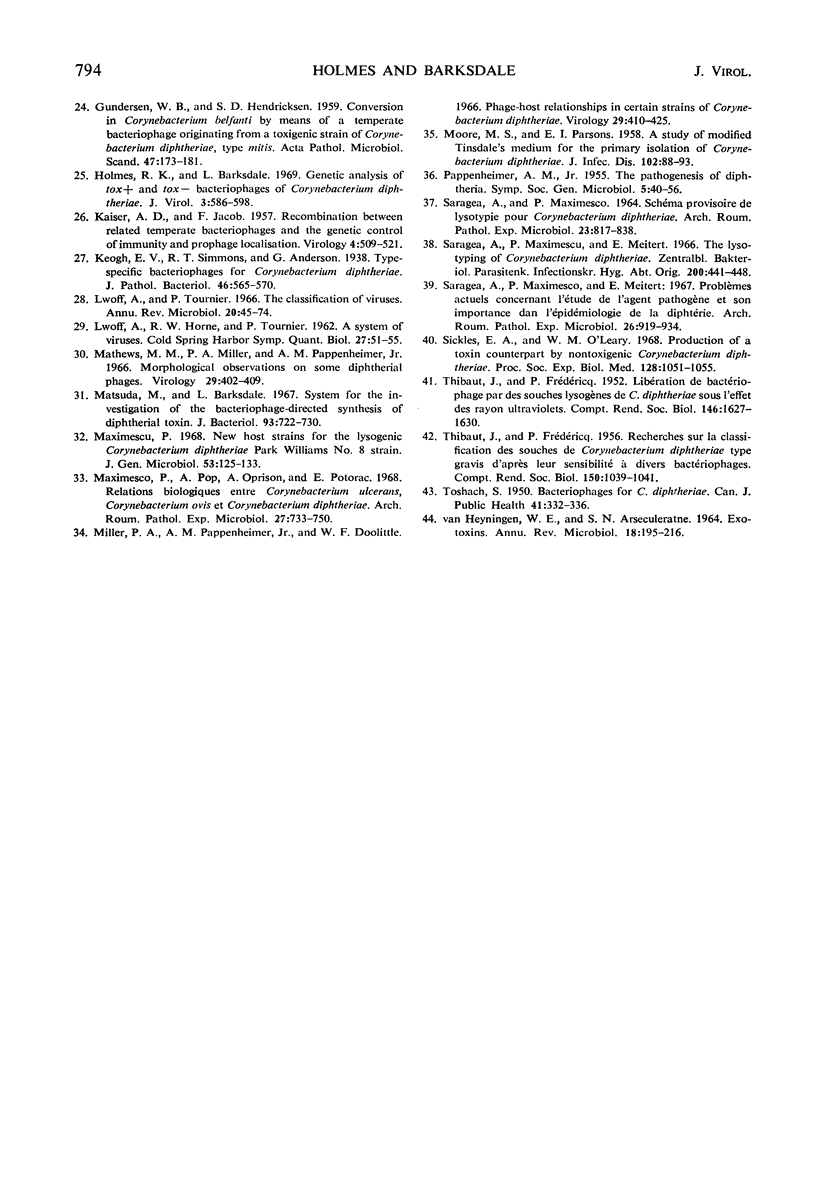
Images in this article
Selected References
These references are in PubMed. This may not be the complete list of references from this article.
- Arber W. Host-controlled modification of bacteriophage. Annu Rev Microbiol. 1965;19:365–378. doi: 10.1146/annurev.mi.19.100165.002053. [DOI] [PubMed] [Google Scholar]
- BARDSDALE W. L., PAPPENHEIMER A. M., Jr Phage-host relationships in nontoxigenic and toxigenic diphtheria bacilli. J Bacteriol. 1954 Feb;67(2):220–232. doi: 10.1128/jb.67.2.220-232.1954. [DOI] [PMC free article] [PubMed] [Google Scholar]
- BARKSDALE L., GARMISE L., RIVERA R. Toxinogeny in Corynebacterium diphtheriae. J Bacteriol. 1961 Apr;81:527–540. doi: 10.1128/jb.81.4.527-540.1961. [DOI] [PMC free article] [PubMed] [Google Scholar]
- BARKSDALE L. Sur quelques bactériophages de Corynebacterium diphtheriae et leurs hôtes. C R Hebd Seances Acad Sci. 1955 May 2;240(18):1831–1833. [PubMed] [Google Scholar]
- BOBB D., GROMAN N. B. The effect of non-ionic surface active agents on Corynebacterium diphtheriae phage adsorption. Biochim Biophys Acta. 1957 Dec;26(3):648–649. doi: 10.1016/0006-3002(57)90118-x. [DOI] [PubMed] [Google Scholar]
- Barksdale L. I. : Lysogenic Conversions in Bacteria. Bacteriol Rev. 1959 Dec;23(4):202–212. doi: 10.1128/br.23.4.202-212.1959. [DOI] [PMC free article] [PubMed] [Google Scholar]
- Bradley D. E. Ultrastructure of bacteriophage and bacteriocins. Bacteriol Rev. 1967 Dec;31(4):230–314. doi: 10.1128/br.31.4.230-314.1967. [DOI] [PMC free article] [PubMed] [Google Scholar]
- CHRISTENSEN P. E. Studies on lysogenicity in C. diphtheriae. Acta Pathol Microbiol Scand. 1957;41(1):67–78. doi: 10.1111/j.1699-0463.1957.tb00998.x. [DOI] [PubMed] [Google Scholar]
- COHN M. I. Production of antibodies in experimental animals. Methods Med Res. 1952;5:271–283. [PubMed] [Google Scholar]
- FAHEY J. E. Preliminary observations on phage typing of corynebacterium diphtheriae. Can J Public Health. 1952 Apr;43(4):167–170. [PubMed] [Google Scholar]
- FREDERICQ P., THIBAUT J. Recherches sur la classification des souches de Corynebacterium diphtheriae type gravis d'après leur sensibilité à divers bactériophages. C R Seances Soc Biol Fil. 1956 Sep 26;150(5):1039–1041. [PubMed] [Google Scholar]
- FREEMAN V. J., MORSE I. U. Further observations on the change to virulence of bacteriophage-infected a virulent strains of Corynebacterium diphtheria. J Bacteriol. 1952 Mar;63(3):407–414. doi: 10.1128/jb.63.3.407-414.1952. [DOI] [PMC free article] [PubMed] [Google Scholar]
- FREEMAN V. J. Studies on the virulence of bacteriophage-infected strains of Corynebacterium diphtheriae. J Bacteriol. 1951 Jun;61(6):675–688. doi: 10.1128/jb.61.6.675-688.1951. [DOI] [PMC free article] [PubMed] [Google Scholar]
- GROMAN N. B., BOBB D. The inhibition of adsorption of Corynebacterium diphtheriae phage by tween 80. Virology. 1955 Sep;1(3):313–323. doi: 10.1016/0042-6822(55)90027-1. [DOI] [PubMed] [Google Scholar]
- GROMAN N. B. Diphtheria-phage inhibitor produced by treating the host bacterium with oleic acid. J Bacteriol. 1961 Mar;81:387–393. doi: 10.1128/jb.81.3.387-393.1961. [DOI] [PMC free article] [PubMed] [Google Scholar]
- GROMAN N. B., EATON M., BOOHER Z. K. Studies of mono- and polylysogenic Corynebacterium diphtheriae. J Bacteriol. 1958 Mar;75(3):320–325. doi: 10.1128/jb.75.3.320-325.1958. [DOI] [PMC free article] [PubMed] [Google Scholar]
- GROMAN N. B., EATON M. Genetic factors in Corynebacterium diphtheriae conversion. J Bacteriol. 1955 Dec;70(6):637–640. doi: 10.1128/jb.70.6.637-640.1955. [DOI] [PMC free article] [PubMed] [Google Scholar]
- GROMAN N. B., MEMMER R. Lysogeny and conversion in mitis and mitis-like Corynebacterium diphtheriae. J Gen Microbiol. 1958 Dec;19(3):634–644. doi: 10.1099/00221287-19-3-634. [DOI] [PubMed] [Google Scholar]
- GROMAN N. B., McCORMICK K. Relation between adsorption of diphtheria phage and its inactivation by an oleic acid-activated inhibitor. J Bacteriol. 1961 Mar;81:394–400. doi: 10.1128/jb.81.3.394-400.1961. [DOI] [PMC free article] [PubMed] [Google Scholar]
- GUNDERSEN W. B., HENRIKSEN S. D. Conversion in Corynebacterium belfanti by means of a temperate bacteriophage originating from a toxigenic strain of Corynebacterium diphtheriae, type mitis. Acta Pathol Microbiol Scand. 1959;47:173–181. doi: 10.1111/j.1699-0463.1959.tb04846.x. [DOI] [PubMed] [Google Scholar]
- Holmes R. K., Barksdale L. Genetic analysis of tox+ and tox- bacteriophages of Corynebacterium diphtheriae. J Virol. 1969 Jun;3(6):586–598. doi: 10.1128/jvi.3.6.586-598.1969. [DOI] [PMC free article] [PubMed] [Google Scholar]
- KAISER A. D., JACOB F. Recombination between related temperate bacteriophages and the genetic control of immunity and prophage localization. Virology. 1957 Dec;4(3):509–521. doi: 10.1016/0042-6822(57)90083-1. [DOI] [PubMed] [Google Scholar]
- LWOFF A., HORNE R., TOURNIER P. A system of viruses. Cold Spring Harb Symp Quant Biol. 1962;27:51–55. doi: 10.1101/sqb.1962.027.001.008. [DOI] [PubMed] [Google Scholar]
- Lwoff A., Tournier P. The classification of viruses. Annu Rev Microbiol. 1966;20:45–74. doi: 10.1146/annurev.mi.20.100166.000401. [DOI] [PubMed] [Google Scholar]
- MOORE M. S., PARSONS E. I. A study of a modified Tinsdale's medium for the primary isolation of Corynebacterium diphtheriae. J Infect Dis. 1958 Jan-Feb;102(1):88–93. doi: 10.1093/infdis/102.1.88. [DOI] [PubMed] [Google Scholar]
- Mathews M. M., Miller P. A., Pappenheimer A. M., Jr Morphological observations on some diphtherial phages. Virology. 1966 Jul;29(3):402–409. doi: 10.1016/0042-6822(66)90216-9. [DOI] [PubMed] [Google Scholar]
- Matsuda M., Barksdale L. System for the investigation of the bacteriophage-directed synthesis of diphtherial toxin. J Bacteriol. 1967 Feb;93(2):722–730. doi: 10.1128/jb.93.2.722-730.1967. [DOI] [PMC free article] [PubMed] [Google Scholar]
- Maximesco P., Pop A., Oprişan A., Potorac E. Relations biologiques entre Corynebacterium ulcerans, Corynebacterium ovis et Corynebacterium diphtheriae. (Etude expérimentale) Arch Roum Pathol Exp Microbiol. 1968 Dec;27(4):733–750. [PubMed] [Google Scholar]
- Maximescu P. New host-strains for the lysogenic Corynebacterium diphtheriae Park Williams No. 8 strain. J Gen Microbiol. 1968 Aug;53(1):125–133. doi: 10.1099/00221287-53-1-125. [DOI] [PubMed] [Google Scholar]
- Miller P. A., Pappenheimer A. M., Jr, Doolittle W. F. Phage-host relationships in certain strains of Corynebacterium diphtheriae. Virology. 1966 Jul;29(3):410–425. doi: 10.1016/0042-6822(66)90217-0. [DOI] [PubMed] [Google Scholar]
- Saragea A., Maximesco P., Meitert E. Problèmes actuels concernant l'étude de l'agent pathogène et son importance dans l'épidémiologie de la diphtérie. Arch Roum Pathol Exp Microbiol. 1967 Dec;26(4):919–934. [PubMed] [Google Scholar]
- Saragea A., Maximesco P. Schéma provisoire de lysotypie pour Corynebacterium diphtheriae. Arch Roum Pathol Exp Microbiol. 1964 Dec;23(4):817–838. [PubMed] [Google Scholar]
- Saragea A., Maximescu P., Meitert E. The lysotyping of Corynebacterium diphteriae. II. Distribution of lysotypes in Rumania. Zentralbl Bakteriol Orig. 1966 Aug;200(4):441–448. [PubMed] [Google Scholar]
- THIBAUT J., FREDERICQ P. Libération de bactériophage par des souches lysogènes de C. diphtheriae sous l'effet des rayons ultraviolets. C R Seances Soc Biol Fil. 1952 Oct;146(19-20):1627–1630. [PubMed] [Google Scholar]
- TOSHACH S. Bacteriophages for C. diphtheriae. Can J Public Health. 1950 Aug;41(8):332–336. [PubMed] [Google Scholar]
- VANHEYNINGEN W. E., ARSECULERATNE S. N. EXOTOXINS. Annu Rev Microbiol. 1964;18:195–216. doi: 10.1146/annurev.mi.18.100164.001211. [DOI] [PubMed] [Google Scholar]



